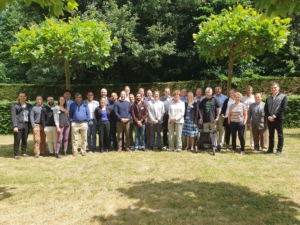Inclusion Body Myositis: 10 years of progress – revision of the ‘ENMC 2013 diagnostic criteria for IBM’ and trial readiness
- Number 272
- Date 16 June 2023
Location: Hoofddorp, The Netherlands
Title: Inclusion Body Myositis: 10 years of progress – revision of the ‘ENMC 2013 diagnostic criteria for IBM’ and trial readiness
Date: 16-18 June 2023
Organisers: Chris Weihl (USA), Marianne de Visser (The Netherlands), Jens Schmidt (Germany)
Participants: Helene Alexandersson (Sweden), Lindsay Alfano (USA), Yves Allenbach (France), Umesh Badrising (The Netherlands), Olivier Benveniste (France), Salman Bhai (USA), Jan De Bleecker (Belgium), Marie Christine Breeveld (patient representative, The Netherlands), Hector Chinoy (UK), Louise Diederichsen (Denmark), Mazen Dimachkie (USA), Steven Greenberg (USA), Mridul Johari (Australia), James Lilleker (UK), Ulrika Lindgren (Sweden), Tom Lloyd (USA), Pedro Machado (UK), Tahseen Mozaffar (USA), Roland Mischke (patient representative, Germany), Elie Naddaf (USA), Merrilee Needham (Australia), Ichizo Nishino (Japan), Anders Oldfors (Sweden), Christiaan Saris (The Netherlands), Werner Stenzel (Germany), Giorgio Tasca (UK)
Translations by:
Arab - Elie Naddaf
Danish - Louise Diederichsen
Dutch - Marie Christine Breeveld, Marianne de Visser
Finnish - Mridul Johari
French - Olivier Benveniste/Yves Allenbach
German - Roland Mischke/Jens Schmidt
Italian - Giorgio Tasca
Japanese - Ichizo Nishino
Swedish - Ulrika Lindgren/Helene Alexandersson
The 272nd ENMC workshop on Inclusion Body Myositis (IBM): “10 years of progress – revision of the ‘ENMC 2013 diagnostic criteria for IBM’ and trial readiness” was held on June 16-18, 2023. Twenty-nine participants from all over the world, including two patient representatives, were brought together to revisit diagnostic criteria, more than 10 years since the 2011 ENMC workshop on IBM. Lessons from current natural history and previous treatment trials were shared to develop consensus guidelines on trial design and outcome measures. Two recently conducted trials in IBM with the drugs Bimagrumab and Arimoclomol failed to meet trial endpoints and this gave rise to discussions on appropriate outcome measures. Identification of promising biomarkers for IBM diagnosis and monitoring of disease progression were the goals of the workshop. It was recommended that currently, in the absence of a disease modifying therapy, management of people with IBM should follow existing standards of care.
At the beginning of the workshop, the two patient representatives set the scene and shared their diagnostic journey with the other participants. They also expressed their wishes about clinical and research priorities: to increase awareness of the disease amongst the general practitioner and other medical specialists who are faced with people with myositis, focus research on unmet patients’ needs, and note the urgent need for the most suitable treatment option of swallowing impairment (dysphagia), which is very bothersome and socially limiting.
The first part of the workshop extensively addressed clinical and pathologic features, both common and uncommon, which was very helpful in drawing up diagnostic criteria. Establishing a diagnosis of IBM as early as possible is paramount and the need for a simple and broad-ranging diagnostic guideline was noted. Such a guideline will not only rule out diseases which may present as mimics of IBM, but also allow for enrollment in future trials. Patients may present with uncommon features, but eventually the typical picture may evolve. Given the serious impact of an IBM diagnosis, discussion regarding muscle biopsy led to the recommendation that at least a minimum set of studies should be performed on the biopsied samples.
Epidemiological studies showed great variability of the frequency of IBM in different parts of the world. Recent studies showed that it is important to recognize that there may be sex- and ethnic-related differences in clinical manifestations, particularly affecting the severity of weakness of the legs and swallowing difficulty. It was convincingly shown that survival is somewhat shortened in IBM patients. In this part of the workshop, the mechanisms of the disease were shown, in particular on the role of inflammation as a driving factor.
The second part of the workshop focused on potential applications of new diagnostic tools. Various imaging tools were presented including muscle MRI (Magnetic Resonance Imaging), ultrasound, and PET (positron Emission Tomography), of which MRI seemed to be the most suitable for advancing the diagnostic approach. Muscle ultrasound appeared to be promising because it is patient-friendly, applicable as a point-of-care tool, and cost effective. It was noted that expertise in performing and interpreting such studies is variable across the world.
Biomarkers in serum and muscle tissue may be used for diagnostic purposes. Serum biomarkers could possibly help in the future to support a diagnosis when a biopsy is not possible.
A major part of the workshop was dedicated to revising the 2011 diagnostic criteria. This aimed to make them as inclusive as possible for enrollment of patients in clinical trials, and, on the other hand, to avoid misdiagnosis of patients. It was emphasized repeatedly that there is an important difference between recommendations for other clinicians on how to diagnose IBM in general healthcare settings compared to recommendations that are required for research studies.
During the third part of the workshop clinical outcome measures were addressed. Which outcomes are currently available and what are their limitations? For future trial design, it is of utmost importance to know the natural history of the disease, though caution should be taken when extrapolating from these studies. It was clear that, in people with IBM, research must be done on outcome measures that assess swallowing difficulties, which is an often unrecognized symptom. Swallowing difficulties are a major determinant of morbidity as the disease advances.
There was consensus on using the IBM-FRS (Functional Rating Scale, a questionnaire assessing the function of arms and legs and swallowing) as an outcome measure for a trial in which a drug is tested for effectiveness and safety. The participants also agreed that, in early trials, quantitative MRI as a biomarker could be used to assess whether a drug works.
Finally, a research agenda was created since many presenters concluded that further research is needed for various outcome measures and biomarkers.
A full report is published in the medical journal Neuromuscular Disorders (PDF).

